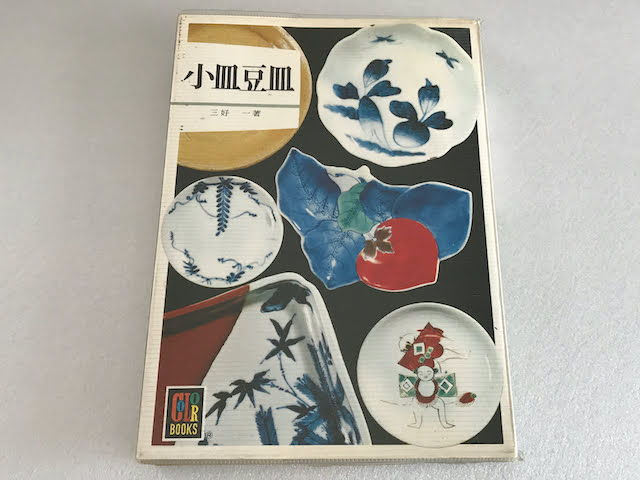のぞき猪口の用途 The use of nozoki-type Imari cups
江戸時代、伊万里ののぞき猪口は刺し身に添える調味料のいれものとしてつかわれていたことはよく知られるところだが、そのことを裏付けるおもしろい文献をみつけた。
Nozoki-type Imari cups are said to be used as containers for sashimi sauce. I saw an interesting reference that shows how the Edo-period people used such small cups.
三好一「小皿豆皿」(保育社カラーブックス346、1975)は日本のアンティークの小皿を写真主体で紹介する本だが、解説文もおもしろい。そのうち「猪口と差味皿」と題するコラムに当時の猪口の用途についていろいろ書いてあった。まず「猪口(ちょく・ちょこ)」ということばがはじめて文献にあらわれるのは1650年代後半のことだという。1710年頃の献立記録には膾皿の脇に長猪口が並んでいて、猪口はメインの皿に付随する脇役だったことがわかるという。伊万里で小型の猪口が量産されはじめたのがおおむね17世紀後半であるから、これら文献の記録とも合致する。おそらくその頃に食文化が変化して、刺し身(著者は「差味」という漢字をあてる)などのかけ汁、つけダレ入れとして磁器の猪口をつかう習慣が徐々にひろまったのだろう。
I found an description about the use of old Imari small cups in a book, Kozara Mamezara (Small and Tiny Plates), Hoiku-Sha, 1975, written by Miyoshi Hajime. According to his book, the word of choko (small cup) is found in the literature from 1650s. It was recorded in a menu in 1710 that a tall choko was served with a namasu (marinated fish) dish. Choko was always a supporting player to the main sashimi (or some kind of fish dishes). Old Imari choko began to be manufactured from the late 17th century, when people began to use a small porcelain cup as a container for sashimi sauce.
そのコラムで引用されている「料理通」が非常に興味深い。これは八百善四代目主人栗山善四郎が1822年〜1835年にわたって著した4分冊の料理本で、抱一らによる挿絵でも知られる。「国文研(国文学研究資料館)データセット簡易Web閲覧」にて閲覧できる。さまざまな献立がずらりと並んでいるが、とくにおもしろいのが2分冊目の「刺味皿の部」だ。四季折々の刺し身とつま、つけダレの取り合わせが紹介されているところまでは他の章とおなじだが、タレをいれる猪口の絵までご丁寧に描かれている点で異彩を放っている。唐草文様とか氷裂文様とかいろいろなデザインの小猪口が見られる。この料理本が書かれた1830年前後には、18世紀に流行したいわゆるのぞき猪口(側面がまっすぐ直立した円筒形の猪口)は(すくなくとも八百善では)あまり人気がなかったようだ。
An old interesting book is referred in his book. The book is Ryori-Tsu (Gourmet), written by Kuriyama Zenshiro from 1822 to 1835 who was an owner of a three-star restaurant, Yaozen, in Edo. It can be seen at #NIJL0113 of Open Dataset of National Institute of Japanese Literature. A lot of four-season menu are listed. Of particular interest is the chapter of sashimi dish, where the picture of the most suitable choko is shown to the main sashimi menu as well as the sauce. We can identify arabesque, broken-ice and more patterns. It seems that the so-called nozoki choko, which was a small cylindrical cup with a straight side surface and was popular in the 18th century, was not used very frequently in Yaozen in 1830s.
From Yaozen, Ryori-Tsu. It is interesting that we can see the fashion of choko in the early 19th cenyury. There are two broken-ice pattern choko. Various sauces are shown such as boiled and condensed sake, mustard miso, and wasabi soy sauce.
このように料理の献立リストにわざわざ猪口の絵が紹介されるということは、刺身皿にどういう猪口を取り合わせるかを、もてなす側ももてなされる側も楽しみにしていたこと、調味料入れとしての猪口が会食のコース料理の中で格別の注目度をもつ(アトラクション的?)存在だったことを暗示する。これは古伊万里の猪口収集家のはしくれとしてもうなずけるところだ。せいぜい直径 5 cm 程度の小さな器ではあるが、古伊万里の小猪口というのはたいへんていねいに作られていて、さまざまな文様、図柄があって、雑な絵付けのものは少ない(いっぽう大型のそば猪口なんかだとやや粗野な絵付けのものも散見する)。まるでままごとでつかうミニチュアの食器のようで、日本人特有の価値観ともいえる「かわいい」器だった。古伊万里の猪口の魅力を再確認した。
The pictures of choko in the menu list imply that both host and guest would pay particular attention to what choko was accompanied with a sashimi dish. Old Imari choko is a mere 5 cm cup but is delicately decorated. It is like a miniature that children play with. It is definitely kawaii tableware. I appreciated old Imari choko again.



